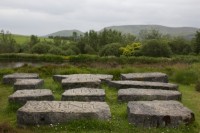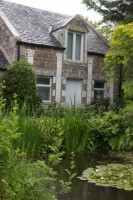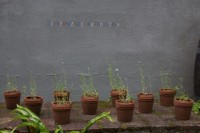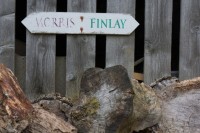Little Sparta: a garden for our times
Twenty five miles outside Edinburgh, often referred to as ‘the Athens of the North’ is its counterpoint, Little Sparta. On Sunday my eldest daughter, her partner and I took a trip out into the Pentland Hills to visit. Little Sparta is the garden of the artist and poet Ian Hamilton Finlay. Described by Sir Roy Strong as ‘.. one of the few made post 1945 which must not be lost. It remains to me still the only really original garden made in this country since that date.’ Strong words. And a visit much anticipated because being remote and in a fragile landscape, it is both hard to reach and rarely open. The stars aligned though and we set off in a car club car (thank goodness for such a civilised mode of transport) through the Edinburgh suburbs and soon into the hills of South Lanarkshire. The walk from the tiny car park isn’t short, but its well worthwhile. The weather wasn’t kind – it drizzled the entire time, and the sun was nowhere to be seen, but it felt appropriate to the landscape which is hardly redolent of Greece. The weather kept visitors to minimum and the size of the gardens allowed us to lose ourselves barley noticing the presence of the dozen or so other visitors.
Finlay, who died in 2006 was a prolific artist and poet and the garden combines the two in his concrete poetry – literally, as the shapes and lines and the choice of different fonts and sizes, as well as the meaning of the words are carved into stone, not by him but by craftsmen collaborators. There are some 275 pieces around the garden. If that sounds a tad overwhelming the space absorbs them well and although it feels like an art gallery it also still feels like a garden. The artworks have several themes, amongst them the French Revolution, WWII, and pre-Socratic views of the nature of the world. The garden is divided into eleven elements including an allotment, a wild garden, a Roman garden and an area called The English Parkland.  There are many striking inscriptions and sculptures, not least the one overlooking the lochan (small loch) set out on eleven large stones saying ‘The present order is the disorder of the future. Saint Just’. Equally dramatic is the stone byre converted into a temple to Apollo with Corinthian and Ionic columns painted onto the front with an inscription ‘To Apollo, his music, his missiles, his muses’ set in one of the more homely elements of the garden the temple pool garden, with a gorgeous lily pond in front of it.
There are many striking inscriptions and sculptures, not least the one overlooking the lochan (small loch) set out on eleven large stones saying ‘The present order is the disorder of the future. Saint Just’. Equally dramatic is the stone byre converted into a temple to Apollo with Corinthian and Ionic columns painted onto the front with an inscription ‘To Apollo, his music, his missiles, his muses’ set in one of the more homely elements of the garden the temple pool garden, with a gorgeous lily pond in front of it. Wandering through the wild area by the lochan I came across all kinds of carved inscriptions such as ‘The world has been empty since the Romans. St Just’ (him again). True, but they never got as far as South Lanarkshire; the Antonine Wall is some way south. One of the most charming elements is the series of small flowerpots on a stone shelf, each one with the name of a female French revolutionary and on the wall of the house behind the caption ‘Les femmes de la Revolution’.
Wandering through the wild area by the lochan I came across all kinds of carved inscriptions such as ‘The world has been empty since the Romans. St Just’ (him again). True, but they never got as far as South Lanarkshire; the Antonine Wall is some way south. One of the most charming elements is the series of small flowerpots on a stone shelf, each one with the name of a female French revolutionary and on the wall of the house behind the caption ‘Les femmes de la Revolution’.  The house isn’t lived in any more which is a pity and the whole place is quite low key – the lady taking the money sells a few postcards and pamphlets but trade was slow. She did have time to answer my question about the little wooden sign round the back which didn’t look as if it had the mark of the great man about it, saying ‘Morris : Finlay’. Something to do with two great artists perhaps?
The house isn’t lived in any more which is a pity and the whole place is quite low key – the lady taking the money sells a few postcards and pamphlets but trade was slow. She did have time to answer my question about the little wooden sign round the back which didn’t look as if it had the mark of the great man about it, saying ‘Morris : Finlay’. Something to do with two great artists perhaps?  No, it was to direct the heating oil delivery men to the correct tanks for this and a neighbouring households winter fuel supplies.
No, it was to direct the heating oil delivery men to the correct tanks for this and a neighbouring households winter fuel supplies.

